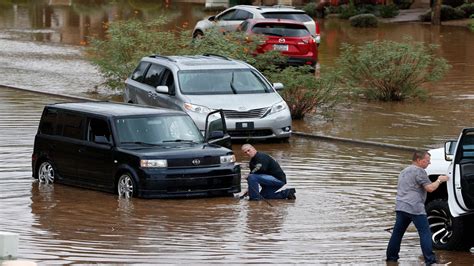
The remnants of Tropical Storm Alvin are poised to unleash heavy rainfall across the Desert Southwest, potentially triggering flash flooding and posing risks to both residents and infrastructure in the region.
The National Weather Service (NWS) has issued warnings and advisories, urging communities from southern California to Arizona and New Mexico to prepare for significant precipitation and potential hazards associated with the storm’s remnants. What was once a tropical storm in the Pacific Ocean is now a moisture-laden system heading inland, threatening to disrupt daily life and challenge the region’s arid landscape.
The storm’s impact is expected to peak over the next few days, with the heaviest rainfall concentrated in areas already saturated from recent storms. Forecasters are particularly concerned about the potential for flash floods in canyons, washes, and urban areas with poor drainage.
“We are closely monitoring the situation and urge residents to stay informed and take necessary precautions,” stated a representative from the National Weather Service in a press briefing. “The risk of flash flooding is significant, and people should avoid low-lying areas and never drive through flooded roadways.”
The remnants of Alvin are part of a larger weather pattern affecting the western United States, bringing a mix of challenges and opportunities to different regions. While the Desert Southwest braces for potential flooding, other areas may benefit from the much-needed rainfall, which could help alleviate drought conditions and reduce wildfire risks.
Background and Development of Tropical Storm Alvin
Tropical Storm Alvin initially formed off the coast of Mexico in the eastern Pacific Ocean. According to the National Hurricane Center (NHC), Alvin developed rapidly due to favorable atmospheric conditions, including warm sea surface temperatures and low wind shear. At its peak, Alvin had sustained winds of approximately 45 mph, classifying it as a tropical storm.
However, as Alvin moved northward, it encountered cooler waters and increased wind shear, leading to its gradual weakening. By the time it reached the coast of Baja California, Alvin had been downgraded to a tropical depression. Despite losing its tropical characteristics, the storm’s moisture remained intact, setting the stage for its inland impact on the Desert Southwest.
The transition from a tropical storm to a remnant low is a common occurrence, but it doesn’t diminish the potential hazards. These remnants can still carry significant amounts of moisture, capable of producing heavy rainfall and flooding far inland. The key factor is the interaction of the remnant moisture with existing weather systems, which can amplify the precipitation and spread it over a wider area.
Impact on the Desert Southwest
The Desert Southwest is particularly vulnerable to flash flooding due to its unique topography and arid climate. The region’s steep canyons, dry washes, and impermeable soil contribute to rapid runoff during heavy rainfall events. Urban areas with extensive pavement and limited drainage infrastructure are also at high risk.
The NWS has identified several areas of concern, including:
- Southern California: Mountainous regions and desert areas are at risk of flash floods and debris flows. Major cities like Los Angeles and San Diego could experience localized flooding and traffic disruptions.
- Arizona: The entire state is under alert, with the highest risk concentrated in the central and southern regions. The Phoenix metropolitan area, along with cities like Tucson and Flagstaff, could face significant rainfall and flooding.
- New Mexico: Eastern and southern parts of New Mexico are likely to receive the heaviest rainfall. Cities like Albuquerque and Las Cruces are preparing for potential flooding and disruptions.
The impact of Alvin’s remnants extends beyond immediate flooding. The heavy rainfall could also trigger landslides and debris flows in mountainous areas, damaging roads, bridges, and other infrastructure. Agricultural areas may experience crop damage due to excessive moisture, and water resources could be strained by the sudden influx of runoff.
“We are working closely with local authorities to ensure that communities are prepared for the potential impacts of this storm,” said a spokesperson for the Federal Emergency Management Agency (FEMA). “We have deployed resources to the region and are ready to provide assistance if needed.”
Preparedness and Safety Measures
In anticipation of the storm, emergency management agencies are urging residents to take the following precautions:
- Stay informed: Monitor weather forecasts and alerts from the National Weather Service and local news outlets.
- Avoid flooded areas: Never drive, walk, or swim through flooded roadways or waterways.
- Prepare an emergency kit: Include essential supplies such as water, food, medications, and a flashlight.
- Clear drainage areas: Remove debris from gutters, drains, and culverts to prevent blockages.
- Have a communication plan: Establish a way to communicate with family members in case of emergencies.
For residents living in flood-prone areas, additional measures may be necessary, such as elevating valuable items, reinforcing foundations, and having flood insurance.
“It’s important to remember that flash floods can occur rapidly and without warning,” warned a local emergency manager. “Be prepared to evacuate if necessary and follow the instructions of local authorities.”
Long-Term Implications and Climate Change Considerations
The increasing frequency and intensity of extreme weather events, including tropical storms and heavy rainfall, are raising concerns about the impacts of climate change. Warmer ocean temperatures and altered atmospheric patterns are contributing to more powerful and unpredictable storms, posing significant challenges to communities around the world.
In the Desert Southwest, climate change is exacerbating the region’s vulnerability to flooding. As temperatures rise, the atmosphere can hold more moisture, leading to heavier rainfall events. At the same time, prolonged droughts are weakening the soil and vegetation, making it more susceptible to erosion and runoff.
“Climate change is a threat multiplier,” explained a climate scientist. “It’s not only increasing the frequency and intensity of extreme weather events, but it’s also making our communities more vulnerable to their impacts.”
Addressing the challenges of climate change will require a comprehensive approach, including reducing greenhouse gas emissions, investing in climate resilience measures, and improving disaster preparedness. This includes upgrading infrastructure to better withstand extreme weather events, implementing more effective land management practices, and developing early warning systems to alert communities of impending threats.
Economic and Social Impacts
The economic impacts of flooding can be substantial, including damage to homes and businesses, disruptions to transportation and commerce, and increased costs for emergency response and recovery. Socially, flooding can displace communities, disrupt livelihoods, and exacerbate existing inequalities.
Low-income communities and marginalized populations are often disproportionately affected by flooding, as they may lack the resources to prepare for and recover from disasters. This can lead to long-term economic hardship and social disruption.
“We need to ensure that our disaster preparedness and response efforts are equitable and inclusive,” said a community advocate. “We must prioritize the needs of the most vulnerable populations and provide them with the resources they need to build resilience.”
Lessons Learned from Past Events
The Desert Southwest has experienced numerous flooding events in the past, providing valuable lessons for future preparedness and response. These include:
- The importance of early warning systems: Accurate and timely warnings can give communities valuable time to prepare and evacuate.
- The need for comprehensive flood management plans: Effective flood management requires a coordinated approach involving government agencies, community organizations, and residents.
- The role of infrastructure improvements: Upgrading drainage systems, building flood control structures, and implementing green infrastructure can help reduce flood risks.
- The value of community engagement: Engaging residents in disaster preparedness and planning can build resilience and foster a sense of shared responsibility.
By learning from past events and investing in preparedness, the Desert Southwest can better protect its communities from the impacts of flooding.
The Current Situation as of [Current Date]
As of [Current Date], the remnants of Tropical Storm Alvin are continuing to move inland, bringing heavy rainfall to the Desert Southwest. The National Weather Service has extended flood warnings and advisories for several areas, and emergency management agencies are coordinating response efforts.
Residents are urged to stay informed, take necessary precautions, and heed the warnings of local authorities. The potential for flash flooding remains high, and communities should be prepared to evacuate if necessary.
The situation is evolving rapidly, and updates will be provided as new information becomes available.
Detailed Weather Forecast and Expected Rainfall Amounts
According to the National Weather Service, the heaviest rainfall is expected to occur between [Start Date] and [End Date]. Rainfall amounts could range from 1 to 3 inches in most areas, with localized amounts exceeding 5 inches in mountainous regions.
The highest risk of flash flooding is in areas with steep terrain, narrow canyons, and poor drainage. Urban areas are also at risk due to the limited capacity of storm drains and the potential for clogged waterways.
The NWS is closely monitoring river levels and reservoir capacities to assess the potential for widespread flooding. Dam operators are taking precautions to manage water releases and prevent overflows.
Specific Areas Under Threat
Several specific areas in the Desert Southwest are facing a heightened risk of flooding. These include:
- The Mogollon Rim in Arizona: This mountainous region is prone to flash floods and debris flows due to its steep slopes and heavy rainfall.
- The San Bernardino Mountains in California: Recent wildfires have denuded the landscape, increasing the risk of mudslides and flooding.
- The Rio Grande Valley in New Mexico: The river is already running high due to recent rainfall, and additional precipitation could cause it to overflow its banks.
- The Phoenix metropolitan area: The city’s extensive network of canals and washes could be overwhelmed by heavy rainfall, leading to widespread flooding.
Government Response and Coordination
Federal, state, and local government agencies are working together to coordinate the response to the storm. FEMA has deployed resources to the region, including personnel and equipment, to assist with emergency operations.
State emergency management agencies are coordinating with local authorities to provide support and assistance to communities in need. This includes providing shelter, food, and water to displaced residents, as well as clearing debris and repairing damaged infrastructure.
The National Guard has been activated in some states to assist with search and rescue operations and provide security.
Community Initiatives and Volunteer Efforts
In addition to government efforts, community organizations and volunteers are playing a crucial role in the response to the storm. Local charities are providing assistance to displaced residents, and volunteer groups are helping to clear debris and repair damaged homes.
Social media is being used to coordinate volunteer efforts and provide information to the public. Residents are encouraged to check with local organizations to find out how they can help.
Infrastructure Vulnerabilities
The storm is highlighting the vulnerabilities of the region’s infrastructure to extreme weather events. Roads, bridges, and power lines are all at risk of damage from flooding and high winds.
Utility companies are taking precautions to protect their infrastructure, including reinforcing power poles and clearing vegetation around power lines. Transportation agencies are monitoring roads and bridges and closing them as necessary to ensure public safety.
Economic Impact Assessment
The economic impact of the storm is still being assessed, but it is expected to be significant. Damage to homes and businesses, disruptions to transportation and commerce, and increased costs for emergency response and recovery will all contribute to the economic losses.
The agricultural sector is also likely to be affected, as heavy rainfall could damage crops and disrupt planting schedules.
Public Health Concerns
Flooding can pose significant public health risks, including the spread of waterborne diseases, exposure to hazardous materials, and injuries from accidents.
Public health officials are advising residents to take precautions to protect themselves from these risks, including drinking bottled water, avoiding contact with floodwaters, and seeking medical attention if they experience any symptoms of illness.
Mental Health Support
Disasters can have a significant impact on mental health, causing stress, anxiety, and depression. Mental health professionals are providing support to affected residents, including counseling and crisis intervention services.
The Role of Technology in Disaster Response
Technology is playing an increasingly important role in disaster response. Social media, mobile apps, and satellite imagery are being used to monitor the storm, track its impact, and coordinate response efforts.
Drones are being used to assess damage and search for missing persons. Geographic information systems (GIS) are being used to map flood zones and identify areas at risk.
Future Preparedness and Mitigation Strategies
The storm is serving as a reminder of the importance of investing in disaster preparedness and mitigation. This includes upgrading infrastructure, implementing more effective land management practices, and developing early warning systems.
Communities should also develop comprehensive disaster plans and conduct regular drills to ensure that residents are prepared to respond to emergencies.
Conclusion
The remnants of Tropical Storm Alvin pose a significant threat to the Desert Southwest, bringing the potential for heavy rainfall and flash flooding. Residents are urged to stay informed, take necessary precautions, and heed the warnings of local authorities.
The storm is also highlighting the importance of investing in disaster preparedness and mitigation, as well as addressing the challenges of climate change. By working together, government agencies, community organizations, and residents can build resilience and protect their communities from the impacts of extreme weather events.
Frequently Asked Questions (FAQ)
1. What areas are most at risk from the remnants of Tropical Storm Alvin?
The areas most at risk are the Desert Southwest regions, including Southern California, Arizona, and New Mexico. Specifically, mountainous areas, canyons, washes, and urban areas with poor drainage are particularly vulnerable to flash flooding.
2. What precautions should I take to prepare for potential flooding?
Stay informed by monitoring weather forecasts and alerts from the National Weather Service. Avoid flooded areas and never drive, walk, or swim through flooded roadways. Prepare an emergency kit with water, food, medications, and a flashlight. Clear drainage areas around your home and have a communication plan with family members.
3. How can I stay updated on the latest weather conditions and warnings?
You can stay updated by monitoring the National Weather Service (NWS) website, local news outlets, and social media channels of emergency management agencies. Sign up for weather alerts on your smartphone or other devices to receive real-time notifications.
4. What should I do if I live in a flood-prone area?
If you live in a flood-prone area, consider elevating valuable items, reinforcing your home’s foundation, and purchasing flood insurance. Be prepared to evacuate if necessary and follow the instructions of local authorities.
5. How is climate change affecting the risk of flooding in the Desert Southwest?
Climate change is exacerbating the risk of flooding by increasing temperatures, which allows the atmosphere to hold more moisture and leads to heavier rainfall events. Prolonged droughts can also weaken the soil and vegetation, making it more susceptible to erosion and runoff, further increasing the risk of flooding.









